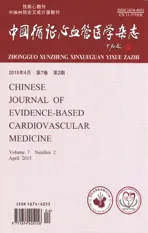男性急性冠状动脉综合征患者性激素、血脂和hs-CRP相关性研究
2015-01-22李秀梅许澎
李秀梅,许澎
• 论著 •
男性急性冠状动脉综合征患者性激素、血脂和hs-CRP相关性研究
李秀梅,许澎
目的探讨男性急性冠状动脉综合征患者性激素睾酮水平、血脂及高敏C反应蛋白(hs-CRP)的相关性。方法连续收集2012年3月~10月于上海市第五人民医院心内科因胸闷、胸痛住院的男性患者共284例,年龄50~80岁。根据冠状动脉(冠脉)造影结果分为急性冠脉综合征组(97例)和稳定性心绞痛组(105例),非冠心病组(82例)。根据冠状动脉造影结果分为三支病变、两支病变、单支病变。检测所有患者血脂、性激素睾酮和hs-CRP水平。并分析各检测指标间的相关性。结果与急性冠脉综合征组比较,稳定性心绞痛组睾酮和三酰甘油(TG)水平升高,差异有统计学意义(P均<0.05),hs-CRP降低,差异有显著统计学意义(P<0.01)。与急性冠脉综合征组比较,非冠心病组睾酮和TG升高,hs-CRP降低,有显著统计学差异(P均<0.01)。非冠心病组较稳定性心绞痛组总胆固醇(TC)、高密度脂蛋白胆固醇(HDL-C)、低密度脂蛋白胆固醇(LDL-C)以及睾酮水平升高,hs-CRP降低,差异有统计学意义(P均<0.05)。男性冠心病睾酮与血脂、hs-CRP水平无明显相关(P均>0.05)。单支病变、双支病变以及三支病变睾酮水平无统计学差异(P均>0.05)。结论男性急性冠脉综合症患者睾酮水平下降、hs-CRP升高,未发现睾酮与血脂、hs-CRP相关,不同冠状动脉病变程度睾酮水平亦无统计学差异。
冠状动脉粥样硬化性疾病;雄激素;CRP;血脂
男性较同年龄女性冠状动脉硬化性心脏病(冠心病)发病率高,激素起着重要的作用。大量文献证实雌激素对女性冠心病发展有保护作用,而男性雄激素睾酮是否影响冠心病发生发展,尚不清楚。研究证实雄激素睾酮与男性冠心病相关,冠心病患者较对照组睾酮水平降低[1]。冠心病患者游离睾酮(FT)、总睾酮(TT)与总胆固醇(TC)、三酰甘油(TG)、低密度脂蛋白胆固醇(LDL-C)呈显著负相关,与高密度脂蛋白胆固醇(HDL-C)呈正相关[2]。高敏C反应蛋白(hs-CRP)是冠心病的危险因素。本研究旨在探讨男性急性冠状动脉(冠脉)综合征患者雄激素睾酮水平与血脂、hs-CRP的关系,进一步了解其在男性冠心病中的作用。
1 资料和方法
1.1 研究对象和分组连续收集2012年3月~10月于上海市第五人民医院心内科因胸闷、胸痛住院的男性患者共284例,年龄50~80岁。根据冠状动脉造影结果分为急性冠脉综合征组(97例)和稳定性心绞痛组(105例)以及结果阴性的非冠心病组(82例)。所有冠心病患者均符合1979年WHO专家委员会确定的诊断标准,并且均行冠脉造影证实。排除风湿性心脏病、心肌病、先天性心脏病等其他心脏病,严重肝肾功能不全、既往口服激素类以及降血脂药物的患者。根据冠状动脉造影结果,冠心病诊断标准以主要血管(即左前降支、左回旋支、右冠状动脉、左主干)管腔狭窄≥50%和(或)其一级分支>70%,分为单支病变,双支病变及三支病变。
1.2 方法收集所有患者年龄、高血压以及糖尿病病史。所有患者入院后在行冠状动脉造影术前抽血检测性激素、血脂及hs-CRP。性激素为血清睾酮,测定采用放射免疫法(GC-911X放射免疫计数仪、T放射免疫试剂盒),按说明书要求进行操作。酶联免疫吸附法检测hs-CRP。
1.3 统计学方法所有数据使用SPSS 13.0进行分析。计量资料采用均数±标准差(±s)表示,组间均数的比较采用方差分析,计数资料采用例数(构成比)表示,组间比较采用χ2检验。相关分析采用Pearson's相关。P<0.05为差异有统计学意义。
2 结果
2.1 三组激素和血脂水平三组年龄、合并高血压比例以及合并糖尿病比例差异无统计学意义(P均>0.05)。与急性冠脉综合征组比较,稳定性心绞痛组睾酮和TG水平升高,差异有统计学意义(P均<0.05),hs-CRP降低,差异有显著统计学意义(P<0.01)。与急性冠脉综合征组比较,非冠心病组睾酮和TG升高,hs-CRP降低,有显著统计学差异(P均<0.01)。非冠心病组较稳定性心绞痛组TC、HDL-C、LDL-C以及睾酮水平升高,hs-CRP降低,差异有统计学意义(P均<0.05)(表1)。
2.2 血脂、hs-CRP和激素相关性相关性分析,男性急性冠脉综合症睾酮与血脂、hs-CRP水平无明显相关(P均>0.05)(表2)。
2.3 冠状动脉不同病变程度激素水平比较单支病变、双支病变以及三支病变睾酮水平无统计学差异(P均>0.05)(表3)。
3 讨论
冠心病危险因素除高血压、吸烟、高血脂、肥胖外,不同性别罹患风险存在差别[3]。研究已证实男性冠心病患者睾酮水平降低[1],与本研究结果一致。有研究表明雄激素降低增加了冠心病死亡率[4],其与冠心病预后的相关性尚不清楚。本研究未显示冠状动脉不同病变程度的睾酮水平有统计学差异,这与新近一项研究结果相似[5]。但也有研究显示三支病变患者睾酮水平更低[7]。
健康男性青春期后血浆HDL-C水平下降,LDL-C和TG水平升高,随着年龄的增长体内睾酮水平逐渐下降,HDL-C轻度升高,提示睾酮影响血脂水平[6]。有研究表明冠心病患者游离睾酮、总睾酮与TC、TG和LDL-C呈显著负相关,与HDL-C呈正相关[2],Blouin等[8]认为雄激素对调节脂肪分布起关键作用,可减少脂肪生成,降低脂肪酸合成,增强脂解作用等。有些研究则认为睾酮与血脂无相关性,而与雌激素有关[7],其机制为睾酮转为雌激素导致睾酮水平降低,雌激素激发了LDL-C的降解,减少了LDL-C的氧化[9]。雌激素通过和受体结合,作用于血管产生舒张作用,同时还参与调节前列腺素、一氧化氮的分泌、抑制血管平滑肌细胞的增生[10]。
hs-CRP是冠心病的独立危险因子。本研究中急性冠脉综合征患者hs-CRP显著升高。研究认为睾酮也参与了炎症过程,可能的机制为中性粒细胞表达CD11/CD18,可刺激炎症因子的分泌,睾酮通过与受体结合,影响核因子NF-κB和活化蛋白-1的活化,间接抑制中性粒细胞表达CD11/ CD18,从而抑制炎症因子的分泌[11]。
有实验表明,不稳定型心绞痛患者游离睾酮水平与白介素-6、肿瘤坏死因子-α呈负相关[12]。冠心病合并糖尿病患者,总睾酮与hs-CRP呈负相关(r=0.21,P=0.01),而且胰岛素治疗的患者较未接受胰岛素治疗者游离睾酮更低[13]。而另外一些研究则表明老年男性睾酮替代治疗后,睾酮对hs-CRP并未产生影响,而绝经后女性雌激素和hs-CRP的相关性更加明确,雌激素治疗后hs-CRP降低[14]。本研究显示冠心病组hs-CRP较非冠心病组升高,而且急性冠脉综合征患者hs-CRP升高更明显,但冠心病组睾酮和hs-CRP无明显相关(P=0.836)。
急性冠脉综合征患者睾酮下降,与其死亡率升高有关,而且动脉粥样硬化患者睾酮下降[15]。睾酮对冠心病的影响可通过其他冠心病危险因素起作用,男性性腺功能减退导致了代谢综合症,增加了冠心病的发生[16],男性前列腺癌性腺功能减退者舒张压升高,而经过9个月的睾酮替代治疗后可使舒张压降低[17]。
总之,急性冠脉综合征患者睾酮下降、hs-CRP升高,男性睾酮可能通过血脂、炎症等过程参与冠心病的发生发展,但本研究未发现睾酮与血脂、hs-CRP的相关性。
[1] Sieminska L,Wojciechowska C,Swietochowska E,et al. Serum free testosterone in men with coronary artery atherosclerosis[J]. Med Sci Monit,2003,9(5):CR162-CR6.
[2] Wu FC,von Eckardstein A. Androgens and coronary artery disease[J]. Endocrin Rev,2003,24(2):183-217.
[3] Ng MK. New perspectives on Mars and Venus: unravelling the role of androgens in gender differences in cardiovascular biology and disease[J]. Heart Lung Circ,2007,16(3):185-92.
[4] Laughlin GA,Barrett-Connor E,Bergstrom J. Low serum testosterone and mortality in older men[J]. J Clin Endocrinol Metab,2008,93(1):68-75.
[5] Davoodi G,Amirezadegan A,Borumand MA,et al. The relationship between level of androgenic hormones and coronary artery disease in men[J]. Cardiovascular J Afr,2007,18(6):362-6.
[6] 胥学伟,李小鹰. 雄性激素和血脂的关系[J]. 中华老年心脑血管病杂志,2003,5(4):283-4.
[7] Wranicz JK,Cygankiewicz I,Rosiaka M,et al. The relationship between sex hormones and lipid profile in men with coronary artery disease[J]. Int J Cardiol,2005,101(1):105-10.
[8] Blouin K,Boivin A,Tchernof A. Androgens and body fat distribution[J]. J Steroid Biochem Mol Biol,2008,108(3-5):272-80.
[9] Wagner JD,Clarkson TB,St Clair RW,et al. Estrogen and progesterone replacement therapy reduces low density lipoprotein accumulation in the coronary arteries of surgically postmenopausal cynomolgus monkeys[J]. J Clin Invest,1991,88(6):1995-2002.
[10] Tolbert T,Oparil S. Effects of estrogen on cardiovascular responses of premenopausal monkeys[J]. Am J Hypertens,2001,14:186S-93S.
[11] Pfeilschifter J,Koditz R,Pfohl M,et al. Changes in proinflammatory cytokine activity after menopause[J]. Endor Rev,2002,23(1):90-119.
[12] 夏大胜,曹晶,王彦欧,等. 男性不稳定型心纹痛患者血清雄激素与中性粒细胞表达CD11/CD18及其与细胞因子的关系[J]. 天津医科大学学报,2005,33(10):632-5.
[13] Ponikowska B,Jankowska EA,Maj J,et al. Gonadal and adrenal androgen deficiencies as independent predictor of increased cardiovascular mortality in men with type II diabetes mellitus and stable coronary artery disease[J]. Int J Cardiol,2010,143(3):343-8.
[14] Cushman M,Legault C,Barrett-Connor E,et al. Effect of postmenopausal hormones on in ammation-sensitive proteins.The PostmenopausalEstrogen/ProgestinInterventions (PEPI)Study[J]. Circulation,1999,100:717-22.
[15] Hak A,Witteman J,de Jong F,et al. Low levels of endogenous androgens increase the risk of atherosclerosis in elderly men: the Rotterdam study[J]. J Clin Endocrinol Metab,2002,87(8):3632-9.
[16] Traish AM,Guay A,Feeley R,et al. The dark side of testosterone de ciency: I. metabolic syndrome and erectile dysfunction[J]. J Androl,2009,30(1):10-22.
[17] Smith MR,Bennett S,Evans L,et al. The effects of induced hypogonadism on arterial stiffness, body composition, and metabolic parameters in males with prostate cancer[J]. J Clin Endocrinol Metab,2001,86(9):4261-7.
Correlation among sex hormones, blood fat and high-sensitivity C-reactive protein in male patients with acute coronary syndrome
LI Xiu-mei*, XU Peng.*Department of Cardiology, Shanghai Fifth People's Hospital, Fudan University, Shanghai 200240, China.
ObjectiveTo investigate the correlation among sex hormones, blood fat and high-sensitivity C-reactive protein (hs-CRP) in male patients with acute coronary syndrome (ACS).MethodsMale patients (n=284, aged from 50 to 80) hospitalized due to chest oppression and chest pain were chosen from Mar. 2012 to Oct. 2012. All patients were divided, according to outcomes of coronary angiography (CAG), into acute coronary syndrome group (ACS group, n=97), stable angina pectoris group (SAP group, n=105) and non-CHD group (n=82). The outcomes of CAG showed that coronary artery lesion included 3-vessel lesion, 2-vessel lesion and 1-vessel lesion. The levels of blood fat, testosterone and hs-CRP were detected and correlation among these indexes was analyzed.ResultsThe levels of testosterone and triglyceride (TG) increased (all P<0.05), and hs-CRP level decreased (P<0.01) in SAP group compared with ACS group. The levels of testosterone and TG increased and hs-CRP level decreased in non-CHD group compared with ACS group (all P<0.01). The levels of total cholesterol (TC), high-density lipoproteincholesterol (HDL-C), low-density lipoprotein-cholesterol (LDL-C) and testosterone increased, and hs-CRP level decreased in non-CHD group compared with SAP group (all P<0.05). The level of testosterone was not correlated to levels of blood fat and hs-CRP (all P>0.05). The level of testosterone had no statistical difference in patients with 1-vessel lesion, 2-vessel lesion or 3-vessel lesion (all P>0.05).ConclusionThe level of testosterone decreases and hs-CRP level increases in male patients with ACS. The correlation has not been found among testosterone, blood fat and hs-CRP. There is no statistical difference in patients with different severity of coronary lesion.
Coronary atherosclerosis; Androgens; C-reactive protein; Blood fat
R541.4
A
1674-4055(2015)02-0242-03
2014-12-03)
(责任编辑:姚雪莉)
200240 上海,复旦大学附属上海市第五人民医院心内科
李秀梅,E-mail:lxm388256@163.com
10.3969/j.1674-4055.2015.02.27
